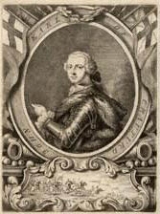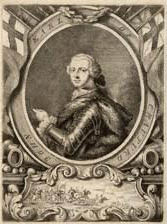
John Lindsay, 20th Earl of Crawford
Encyclopedia

Scotland
Scotland is a country that is part of the United Kingdom. Occupying the northern third of the island of Great Britain, it shares a border with England to the south and is bounded by the North Sea to the east, the Atlantic Ocean to the north and west, and the North Channel and Irish Sea to the...
peer
Peerage of Scotland
The Peerage of Scotland is the division of the British Peerage for those peers created in the Kingdom of Scotland before 1707. With that year's Act of Union, the Kingdom of Scotland and the Kingdom of England were combined into the Kingdom of Great Britain, and a new Peerage of Great Britain was...
and the first colonel
Colonel
Colonel , abbreviated Col or COL, is a military rank of a senior commissioned officer. It or a corresponding rank exists in most armies and in many air forces; the naval equivalent rank is generally "Captain". It is also used in some police forces and other paramilitary rank structures...
of the Black Watch
Black Watch
The Black Watch, 3rd Battalion, Royal Regiment of Scotland is an infantry battalion of the Royal Regiment of Scotland. The unit's traditional colours were retired in 2011 in a ceremony led by Queen Elizabeth II....
on its formation in 1739.
He was the son of Lt.-Gen. John Lindsay, 19th Earl of Crawford
John Lindsay, 19th Earl of Crawford
John Lindsay, 19th Earl of Crawford and 3rd Earl of Lindsay was a Scottish peer and politician. He succeeded to the earldoms in 1698 on the death of his father William Lindsay, 18th Earl of Crawford. He was elected as one of the first representative peers in February of 1707, and so served until...
and Emilia Stuart and inherited his titles on the death of his father in 1714.
He was educated at University of Glasgow
University of Glasgow
The University of Glasgow is the fourth-oldest university in the English-speaking world and one of Scotland's four ancient universities. Located in Glasgow, the university was founded in 1451 and is presently one of seventeen British higher education institutions ranked amongst the top 100 of the...
and the Vaudeuil Military Academy, Paris
Paris
Paris is the capital and largest city in France, situated on the river Seine, in northern France, at the heart of the Île-de-France region...
.
He was commissioned into the 3rd Foot Guards
Scots Guards
The Scots Guards is a regiment of the Guards Division of the British Army, whose origins lie in the personal bodyguard of King Charles I of England and Scotland...
in 1726, but later served in the Austria
Austria
Austria , officially the Republic of Austria , is a landlocked country of roughly 8.4 million people in Central Europe. It is bordered by the Czech Republic and Germany to the north, Slovakia and Hungary to the east, Slovenia and Italy to the south, and Switzerland and Liechtenstein to the...
n and Russia
Russia
Russia or , officially known as both Russia and the Russian Federation , is a country in northern Eurasia. It is a federal semi-presidential republic, comprising 83 federal subjects...
n armies before returning to Britain and taking command of the Black Watch (1739–1740). He was then Colonel of the 2nd Troop of Horse Grenadier Guards
Horse Grenadier Guards
The Horse Grenadier Guards were a series of cavalry troops in the British Household Cavalry between 1687 and 1788, who used grenades and other explosives in battle. Originally attached to the Horse Guards, they became independent for a century before being disbanded...
(1740–1743) and Colonel of the 4th Troop of Horse Guards
Horse Guards Regiment
The Horse Guards Regiment was a regiment only in name: it actually consisted of several independent troops raised initially on the three different establishments...
('Scottish Horse Guards') (1743–1746), fighting at the Battle of Dettingen
Battle of Dettingen
The Battle of Dettingen took place on 27 June 1743 at Dettingen in Bavaria during the War of the Austrian Succession. It was the last time that a British monarch personally led his troops into battle...
on 16 June 1743. He gained the rank of Brigadier-General in 1744 and Major-General in 1745. He fought in the Jacobite Uprising in 1745 and the Battle of Fontenoy
Battle of Fontenoy
The Battle of Fontenoy, 11 May 1745, was a major engagement of the War of the Austrian Succession, fought between the forces of the Pragmatic Allies – comprising mainly Dutch, British, and Hanoverian troops under the nominal command of the Duke of Cumberland – and a French army under Maurice de...
on 30 April 1745.
He was Colonel of the 25th Foot (1746–1747). He fought in the Battle of Roucoux on 11 October 1746 and gained the rank of Lieutenant-General in 1747. He was Colonel of the 2nd Dragoons ('Scots Greys') (1747–1749)
In 1732 he was elected Fellow of the Royal Society. In 1734 he was Grand Master
Grand Master (Masonic)
In Freemasonry a Grand Master is the leader of the lodges within his Masonic jurisdiction. He presides over a Grand Lodge, and has certain rights in the constituent lodges that form his jurisdiction....
of the Premier Grand Lodge of England
Premier Grand Lodge of England
The Premier Grand Lodge of England was founded on 24 June 1717 as the Grand Lodge of London and Westminster and it existed until 1813 when it united with the Ancient Grand Lodge of England to create the United Grand Lodge of England. It was the first Masonic Grand Lodge to be created...
.
He had married Lady Jean Murray, daughter of Lt.-Col. Sir James Murray, 2nd Duke of Atholl
James Murray, 2nd Duke of Atholl
James Murray, 2nd Duke of Atholl KT PC , styled Marquess of Tullibardine between 1715 and 1746, was a Scottish peer.-Background:...
, in 1747 but she died only 9 months after their marriage. He died on 26 December 1749 from a head wound received at the Battle of Krotzka in 1739. He was the last member of the Lindsay family to be buried in the mausoleum
Mausoleum
A mausoleum is an external free-standing building constructed as a monument enclosing the interment space or burial chamber of a deceased person or persons. A monument without the interment is a cenotaph. A mausoleum may be considered a type of tomb or the tomb may be considered to be within the...
in the cemetery at Ceres, Fife
Ceres, Fife
Ceres is a village in Fife, Scotland, located in a small glen approximately 2 miles over the Ceres Moor from Cupar and 7 miles from St Andrews. The former parish of that name included the settlements of Baldinnie, Chance Inn, Craigrothie, Pitscottie and Tarvit Mill.-The village:It is one of the...
, Scotland
Scotland
Scotland is a country that is part of the United Kingdom. Occupying the northern third of the island of Great Britain, it shares a border with England to the south and is bounded by the North Sea to the east, the Atlantic Ocean to the north and west, and the North Channel and Irish Sea to the...
.

